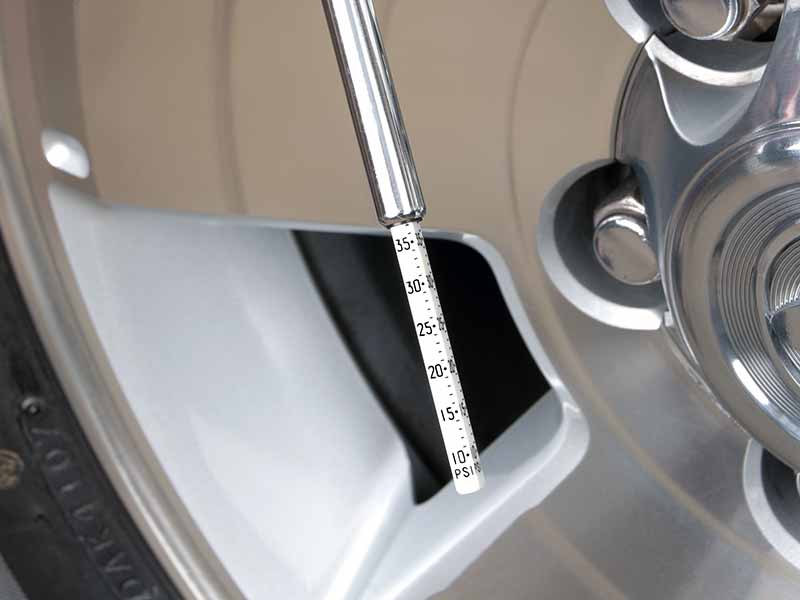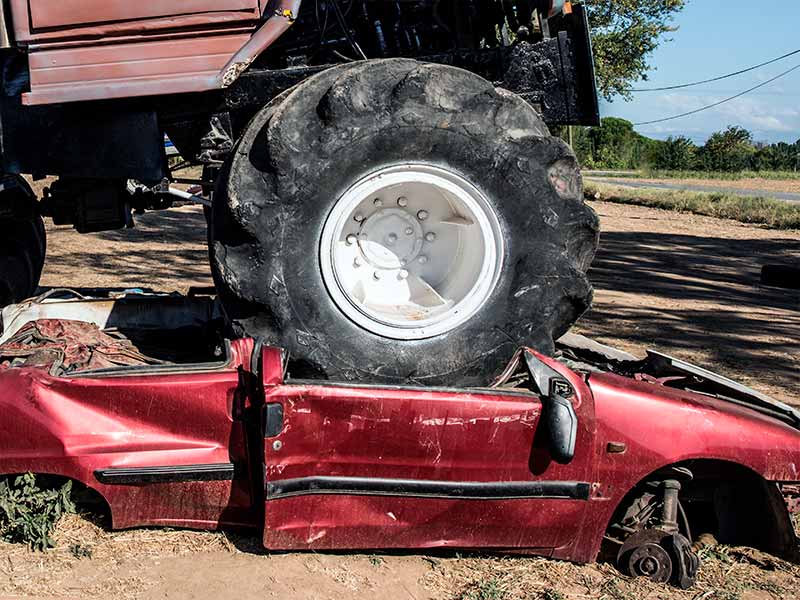Have you ever wondered how changing tire sizes affects the air pressure your tires need? Whether upsizing for a rugged look or downsizing for efficiency, understanding tire pressure adjustments is essential for maintaining your vehicle’s performance and safety.
How To Calculate Tire Pressure for Bigger Tires
To calculate tire pressure for bigger or smaller tires, start with the manufacturer’s recommended pressure for the original size, then adjust based on the new tires’ load capacity and size using our tire pressure calculator.
In this article, we delve into the intricacies of calculating tire pressure for different tire sizes, understanding load index, the significance of maximum tire pressure, and practical steps for ensuring your tires are always optimally inflated.

The Importance of Tire Pressure
Tire pressure, measured in pounds per square inch (PSI), is the amount of air in your tires. Proper tire pressure is essential for:
- Fuel Efficiency: Correctly inflated tires reduce rolling resistance, which can improve fuel economy.
- Tire Longevity: Maintaining the right tire pressure helps prevent premature tire wear.
- Safety: Adequate tire pressure is vital for optimal traction, handling, and braking performance.
- Ride Comfort: Well-inflated tires can absorb road irregularities more effectively, enhancing ride comfort.
Consequences of Incorrect Tire Pressure
Failing to keep your tires at the correct pressure can lead to several problems:
- Under-inflation: This can cause increased tire wear, reduced fuel efficiency, and potential tire failure.
- Over-inflation: This may result in a less comfortable ride, reduced traction, and uneven tire wear.
For more detailed information about tire sizes and their effects on vehicles, you can visit our guide on How to Calibrate a Speedometer for Bigger Tires.
How to Check Your Tire Pressure
Regular tire pressure checks are crucial. Here’s how to do it effectively:
- Frequency: Check your tire pressure at least once a month and before long journeys.
- Ideal Conditions: Measure tire pressure when the tires are cold, usually in the morning, for accurate readings.
- Tools: Use a reliable tire pressure gauge. Visual inspections are not sufficient.
To find out the recommended tire pressure for different types of vehicles, visit our Recommended Tire Pressure section for comprehensive guidelines.
Tire Pressure for Different Tire Sizes
As you venture into the world of different tire sizes, whether bigger or smaller than your vehicle’s standard, understanding how tire size impacts pressure requirements becomes critical.
Bigger Tires: More Than Just Size
- Volume Increase: Larger tires generally have a larger air volume. This might suggest that they require less pressure to support the same weight. However, the actual pressure needed can vary based on tire construction and vehicle weight.
- Handling and Performance: The pressure in larger tires affects handling characteristics. It’s crucial to find a balance that maintains vehicle stability and tire longevity.
Smaller Tires: Compact but Crucial
- Reduced Volume: Smaller tires have less air volume, which often means they might need higher pressure to support the vehicle’s weight effectively.
- Impact on Ride Quality: Ensuring the correct pressure in smaller tires is essential to avoid a harsh ride and uneven tire wear.
Adjusting Pressure: A Guided Approach
When switching to tires of a different size, here’s how to approach pressure adjustments:
- Start with Manufacturer Recommendations: Always begin with the tire pressure recommended by your vehicle manufacturer for the original tire size.
- Consult Tire Load Ratings: Refer to the Tire Load Ranges guide to understand the load capacity of your new tires.
- Consider Load Capacity: If the new tires have a different load capacity than the originals, adjust the pressure to ensure they can carry the vehicle’s weight effectively.
- Use a Tire Pressure Calculator: This tool can be handy in determining the appropriate pressure for your new tire size. It takes into account factors like vehicle weight, tire size, and load capacity.
- Trial and Adjustment: After setting the new pressure, test drive your vehicle. Pay attention to how it handles and adjust the pressure if necessary.
Practical Tips for Tire Pressure Adjustment
- Never Exceed Limits: Never inflate tires beyond the maximum pressure listed on the tire sidewall.
- Regular Checks: Tire pressure should be checked regularly, especially after changing tire sizes.
- Professional Advice: When in doubt, consult a tire professional to ensure you’re using the correct pressure for your new tires.

Recommended Tire Pressure
The tire pressure information sticker in your driver’s door jamb provides a comprehensive look at the recommended pressures for different tire sizes. Here’s how to use them effectively:
- Locate Your Tire Size: Find the specific size of your new tires on the chart. This size is usually printed on the tire’s sidewall.
- Match with Recommended Pressure: The chart will list the ideal pressure for your tire size, taking into account factors like load and vehicle type.
- Adjust According to Your Vehicle’s Needs: Use a load range chart as a starting point, and then fine-tune the pressure based on your specific vehicle model and driving conditions.
Understanding Tire Pressure/Load Charts
For a more nuanced approach, tire pressure/load charts can be incredibly helpful. These charts go a step further by correlating tire pressure with the load capacity of the tire:
- Load Capacity Insight: Learn how much weight your tires can support at different pressure levels.
- Customize to Vehicle Load: If you often carry heavy loads or tow, these charts can guide you to adjust tire pressure accordingly for safety and efficiency.
Tire Load Index Chart
The full chart ranges from 0 to 150 but we will abbreviate it to 70 through 126 since the more extreme numbers are much less common. You can view the full chart at Discount Tire.
| Load Index | Carrying Capacity (pounds) |
|---|---|
| 70 | 739 |
| 71 | 761 |
| 72 | 783 |
| 73 | 805 |
| 74 | 827 |
| 75 | 853 |
| 76 | 882 |
| 77 | 908 |
| 78 | 937 |
| 79 | 963 |
| 80 | 992 |
| 81 | 1,019 |
| 82 | 1,047 |
| 83 | 1,074 |
| 84 | 1,102 |
| 85 | 1,135 |
| 86 | 1,168 |
| 87 | 1,201 |
| 88 | 1,235 |
| 89 | 1,279 |
| 90 | 1,323 |
| 91 | 1,356 |
| 92 | 1,389 |
| 93 | 1,433 |
| 94 | 1,477 |
| 95 | 1,521 |
| 96 | 1,565 |
| 97 | 1,609 |
| 98 | 1,653 |
| Load Index | Carrying Capacity (pounds) |
|---|---|
| 99 | 1,709 |
| 100 | 1,764 |
| 101 | 1,819 |
| 102 | 1,874 |
| 103 | 1,929 |
| 104 | 1,984 |
| 105 | 2,039 |
| 106 | 2,094 |
| 107 | 2,149 |
| 108 | 2,205 |
| 109 | 2,271 |
| 110 | 2,337 |
| 111 | 2,403 |
| 112 | 2,469 |
| 113 | 2,535 |
| 114 | 2,601 |
| 115 | 2,679 |
| 116 | 2,756 |
| 117 | 2,833 |
| 118 | 2,910 |
| 119 | 2,998 |
| 120 | 3,086 |
| 121 | 3,197 |
| 122 | 3,307 |
| 123 | 3,417 |
| 124 | 3,527 |
| 125 | 3,638 |
| 126 | 3,748 |
Load Index and Tire Pressure
The load index of a tire is a numerical code that corresponds to the maximum load a tire can carry at the pressure indicated by its manufacturer. Understanding the load index is essential when adjusting tire pressure, especially when changing tire sizes.
What is Load Index?
- Definition: The load index is a number that directly corresponds to the maximum weight a tire can support. It’s usually found alongside the tire size on the sidewall.
- Example: A tire with a load index of 91 can carry 1,356 pounds (615 kg) at maximum pressure.
The Relationship Between Load Index and Tire Pressure
- Direct Correlation: The load index assumes the tire is inflated to its optimal pressure. If a tire is under-inflated, it cannot support the weight indicated by its load index.
- Impact on Vehicle Performance: A tire that is not supporting the appropriate load due to incorrect tire pressure can negatively impact vehicle handling, fuel efficiency, and tire lifespan.
Using Load Index to Adjust Tire Pressure
- Identify Your Tire’s Load Index: This information is printed on the tire sidewall and is also available in your vehicle’s manual or tire specification sheets.
- Consult Load Index Tables: These tables, available online or from tire manufacturers, convert the load index number to the corresponding weight capacity.
- Adjust Pressure According to Vehicle Load:
- For Heavier Loads: If you’re carrying loads near the tire’s maximum capacity (as indicated by the load index), ensure the tire is inflated to the higher end of the recommended pressure range.
- For Lighter Loads: If your vehicle is lightly loaded, you can opt for a slightly lower pressure within the recommended range, but never below the minimum.
- Consider Tire Size Changes: When changing to a tire size with a different load index, calculate the new required pressure by considering both the new tire’s load capacity and the vehicle’s weight distribution.
- Regular Checks Are Crucial: Always monitor your tire pressure, especially if your vehicle’s load varies frequently.
Max Pressure
- Definition: Max pressure is the highest amount of air pressure that a tire can safely contain. It is different from the recommended tire pressure, which is the optimal pressure for vehicle performance and efficiency.
- Location: This information is typically found on the tire sidewall, expressed in pounds per square inch (PSI) or bar.
Relationship Between Max Pressure and Recommended Tire Pressure
- Not the Optimal Pressure: Max pressure is not a guideline for everyday driving; it’s a safety limit. The recommended tire pressure, often lower than the max pressure, is provided by the vehicle manufacturer for optimal performance.
- Varies by Tire and Vehicle: Different tires and vehicles have specific recommended pressures, which are determined based on factors like weight distribution, intended use, and tire characteristics.
The Importance of Staying Below Max Pressure
- Risk of Over-inflation: Inflating tires to the max pressure can lead to a harsh ride, reduced traction, and uneven tire wear. It also increases the risk of tire damage and blowouts, especially when driving on rough surfaces or in hot weather.
- Maintaining Vehicle Safety: Properly inflated tires, within the recommended range and below the max pressure, ensure optimal contact with the road, better handling, and braking efficiency.
- Ensuring Tire Longevity: Staying within the recommended range prolongs tire life by preventing excessive stress and wear on the tire structure.
Tips for Monitoring and Maintaining Tire Pressure
- Regular Checks: Frequently check your tire pressure, especially before long trips or carrying heavy loads.
- Use Accurate Tools: Utilize a reliable tire pressure gauge to ensure precise readings.
- Adjusting for Conditions: Remember that tire pressure can increase with temperature. On hot days, the pressure can rise above the recommended level if initially filled to max pressure.
Aftermarket Tire Pressure Calculator
DISCLAIMER: Use this calculator at your own risk. Consult with a tire professional if you’re uncomfortable making the determination of what tire pressure to use on your own.
Step-by-Step Guide to Calculating Tire Pressure
Adjusting tire pressure for different tire sizes doesn’t have to be a guessing game. In this section, we provide a straightforward, step-by-step guide to help you calculate the right tire pressure, whether you’re switching to larger or smaller tires.
Step 1: Start with Manufacturer Recommendations
- Locate Original Specs: Begin with the tire pressure recommended by your vehicle manufacturer for the original tire size. This information is often found in the owner’s manual or on a sticker inside the driver’s door.
Step 2: Consult Tire Load Ratings
- Understand Load Capacity: Refer to your new tires’ load capacity, which can be found on the tire sidewall or in a tire load range chart. Our guide on Tire Load Ranges provides comprehensive insights on this topic.
Step 3: Use a Tire Pressure Calculator
- Input Specifications: Enter details like your vehicle’s make and model, and the size of your new tires into a tire pressure calculator.
- Get Estimated Pressure: The calculator will provide an estimated pressure, which is a good starting point for your new tires.
Step 4: Trial and Adjustment
- Initial Test Drive: After setting the new pressure, take your vehicle for a test drive to assess handling and stability.
- Make Adjustments: Depending on how your vehicle feels, you may need to slightly adjust the pressure up or down. Remember, never to exceed the tire’s maximum pressure rating.
Step 5: Regular Checks and Fine-Tuning
- Consistent Monitoring: Regularly check the tire pressure and adjust as needed, especially with changing temperatures and driving conditions.
- Be Observant: Pay attention to tire wear patterns as they can indicate if adjustments are needed.
Resources
Below are some links you may find helpful when learning about tires
- Tire pressure checker: Righting the pressure in your new tires – 4WheelParts
- What is load index? – TireRack.com
Final Thoughts
Navigating tire pressure calculations for different tire sizes can seem daunting, but with the right approach and tools, it becomes a manageable and vital part of vehicle maintenance.
The key is to start with the recommended pressure for your original tire size and then adjust based on the new tire’s load capacity and size. Regular checks and adjustments are essential for maintaining tire health, vehicle safety, and performance.
Always stay within the safety bounds of maximum pressure and consider the load index when carrying heavy loads. You now have the knowledge to confidently manage tire pressure for any tire size, ensuring your vehicle remains efficient, safe, and enjoyable to drive.
Good luck and happy motoring.





